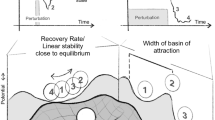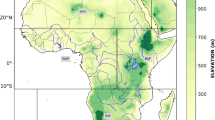Abstract
One of the most important hazards in terms of cost, frequency of occurrence and impact on humans is drought. Drought indices are estimations of precipitation shortage and water supply deficit. Satellite drought indices are normally radiometric recordings of vegetation condition and dynamics, exploiting the unique spectral signatures of canopy elements, particularly in the red and near-infrared bands. However, the identification of drought based on the Reconnaissance Drought Index (RDI) enables the assessment of hydro-meteorological drought, since it uses hydro-meteorological parameters. RDI is a fairly comprehensive index as it combines the simplicity of use and the successfully assessment and monitoring of the phenomenon. However, the study and understanding of the spatiotemporal variability of drought is not an easy process. In this study the main goal is to use the PCA + clustering method to transform the RDI temporal data (1982–2001) and cluster the different regions of Greece based on that temporal variations. Firstly, Principal Component Analysis (PCA) applied onto 19 annual RDI indices followed by Clustering that was based on certain eigenchannels resulted from the previous PCA analysis. Both methods are linear transformations capable to decorrelate the spatiotemporal information provided in the estimated RDI. The time series presented approach proved to be advantageous in relation to other statistical methods used to describe variability and provide excellent and fast results for stakeholders and environmental organizations. The results are quite satisfactory in classifying the drought-induced climatic regions of Greece.





Similar content being viewed by others
References
Domenikiotis C, Spiliotopoulos M, Loukas A, Sarakatsanos S, Dalezios N (2004a) Early cotton production assessment in Greece based on the combination of the Drought Vegetation Condition Index (VCI) and Bhalme and Mooley Drought Index (BMDI). Int J Remote Sens 25(23):5373–5388
Domenikiotis C, Spiliotopoulos M, Tsiros E, Sarakatsanos S, Dalezios N (2004b) Early cotton yield assessment by the use of the NOAA/AVHRR derived drought vegetation condition index in Greece. Int J Remote Sens 25(14):2807–2819
Domenikiotis C, Tsiros E, Spiliotopoulos M, Dalezios N (2005) Zoning of cotton production areas based on NOAA/AVHRR images. International Symposium in GIS and remote sensing: environmental applications, Volos, Greece, pp. 119–132
Fung T, LeDrew E (1987) Application of principal components analysis to change detection. Photogramm Eng Remote Sens 53:1649–1658
Hodgson ME (1988) Reducing the computational requirements of the minimum-distance classifier. Remote Sensing of Environment Vol. 2
Huete AR, Liu HQ, Batchily K, Van Leeuwen W (1997) A comparison of vegetation indices over a global set of TM images for EOS-MODIS. Remote Sens Environ 59:440–451
Huete A, Didan K, Miura T, Rodriguez EP, Gao X, Ferreira LG (2002) Overview of the radiometric and biophysical performance of the MODIS vegetation indices. Remote Sens Environ 83:195–213
Ingebritsen SE, Lyon RJP (1985) Principal components analysis of multitemporal image pairs. Int J Remote Sensing 6:687–696
Kanellou E, Domenikiotis C, Blanta A, Hondronikou E and Dalezios NR, (2008a) Intercomparison of drought indices in semi-arid areas of Greece using conventional data. Proceedings of the International Symposium of Water Shortage Management, Athens, 20, pp. 167–179
Kanellou E, Domenikiotis C, Blanta A, Hondronikou E, Dalezios N (2008b) Index-based drought assessment in semi-arid areas of Greece based on conventional data. European Water (EWRA) 23/24, pp. 87–98
Kanellou E, Tsiros E, Domenikiotis C, Dalezios N (2008c) Drought monitoring using several indices. 4th International Conference on Information and Communication Technologies in Bio and Earth Sciences HAICTA 2008, Athens, Greece, pp. 32–37
Keyantash J, Dracup JA (2002) The quantification of drought: an evaluation of drought indices. Bulletin of American Meteorological Society pp. 1167–1180
Kogan NF (2002) World droughts in the new millennium from AVHRR-based vegetation health indices. EOS Trans American Geophys Union 83(48):562–563
Mariolopoulos E (1938) The Greek climate. University of Athens
New York State, Mitigation Plan Development Team (2008) Drought hazard profile. NYS HAZ MIT PLAN
ESPON Project (2009) European spatial planning observation network. Luxemburg 2007–2013
Raziei T, Bordi I, Pereira LS (2009) An application of GPCC and NCEP/ NCAR datasets for drought monitoring in Iran. Proceedings of the EWRA Seventh International Conference: water resources conservancy and risk reduction under climatic uncertainty, Limassol, Cyprus, pp. 349–356
Richards AJ (1986) Remote sensing digital image analysis. Springer, Verlag
Singh M, (2006) Indentifying and assessing drought hazard and risk in Africa. Regional Conference on Insurance and Reinsurance for Natural Catastrophe Risk in Africa. Casablanca, Morocco
Spyropoulos N, Granger WK (1993) Change detection in Salamis Island, Greece, using landsat TM imagery (1987–1991). Earth observation magazine. Intern J Integ Geotechnol Earth Solutions Volume 2, number 6
Spyropoulos N et al (2010) Land reclamation of surface mining based on imagery intelligence and spatial decision support systems. World Trans Engineer Technol Educ Vol. 8, No.1
Steinemann A, Hayes MJ, Cavalcanti L (2005) Drought indicators and triggers. In: Wilhite D (ed) Drought and water crises, science technology and management issues, Marcer Dekker Publ., pp 71–90
Steven MD, Jaggard KW (1995) Advances in crop monitoring by remote sensing. In: Danson FM, Plummer SE (Eds) Advances in environmental remote sensing, Wiley, pp. 143–156
Thenkabail PS, Gamage MSDN, Smakhtin VU (2004) The use of remote sensing data for drought assessment and monitoring in Southwest Asia. Res Report Intern Water Manag Institute 85:1–25
Tsakiris G, Vangelis H (2005) Establishing a drought index incorporating evapotraspiration. European Water, 9/10, pp. 3–11
Tsakiris G, Pangalou D, Vangelis H (2007) Regional drought assessment based on the Reconnaissance Drought Index (RDI). Water Resour Manag 21(5):821–833
Tsiros E, Domenikiotis C, Spiliotopoulos M, Dalezios N (2004) Use of NOAA/AVHRR-based vegetation condition index (VCI) and temperature condition index (TCI) for drought monitoring in Thessaly, Greece. EWRA Symposium on water resources management: risks and challenges for the 21st century, Izmir, Turkey, pp. 769–782
Vangelis H, Spiliotis M, Tsakiris G (2010) Drought severity based on bivariate probability analysis. Water resource management. Springer Science + Business Media B.V. Published on line
Zeidler J, Chunga R (2006) Strategies for more efficient use of weather and climate information and application for reducing land degradation. Session 4. Arusha, Tanzania. Integrated Environemntal Consultants Nabibia (IECN)
Acknowledgements
The Authors wish to thank NASA for the satellite data provision and JRC for the precipitation data used in the project. The funding was provided by the PRODIM, PLEIADES, PENED, HYDROSENSE and SMART European Commission projects.
Author information
Authors and Affiliations
Corresponding author
Rights and permissions
About this article
Cite this article
Kanellou, E.C., Spyropoulos, N.V. & Dalezios, N.R. Geoinformatic Intelligence Methodologies for Drought Spatiotemporal Variability in Greece. Water Resour Manage 26, 1089–1106 (2012). https://doi.org/10.1007/s11269-011-9948-1
Received:
Accepted:
Published:
Issue Date:
DOI: https://doi.org/10.1007/s11269-011-9948-1




